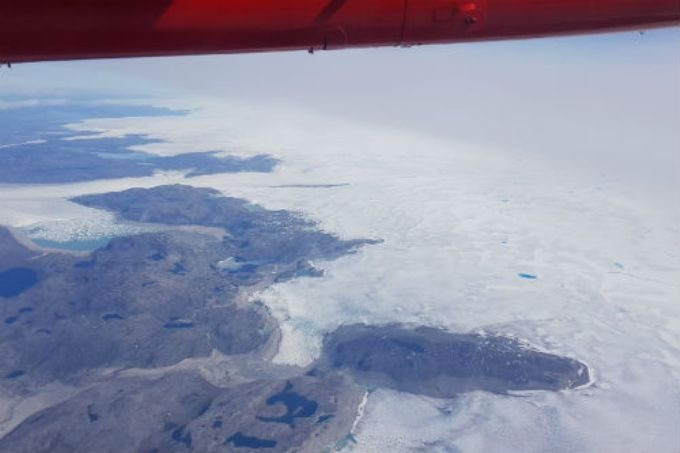Aug 16 2019
In their study of silicon cycling in glacial environments, researchers from the University of Bristol have reported the possible significance of glaciers in carrying silicon to downstream ecosystems.
 Flying over Greenland Ice Sheet—A view of outlet glaciers terminating into the complex fjord network around Greenland. (Image credit: Jade Hatton, University of Bristol)
Flying over Greenland Ice Sheet—A view of outlet glaciers terminating into the complex fjord network around Greenland. (Image credit: Jade Hatton, University of Bristol)
According to the researchers, this could have repercussions in marine primary productivity and could affect the carbon cycle on the timescales of ice ages.
The reason for this is that primary producers, like diatoms (a type of algae that constitute up to 35% of all marine primary productivity), require silica and are capable of removing a large quantity of atmospheric CO2 and transferring it to the deep ocean.
It is important we understand the role glaciers play in silicon cycling and we have examined previously published work considering subglacial weathering and nutrient fluxes to bring together this review, focusing upon the chemical fingerprint of silicon exported from these environments.
Jade Hatton, Study Lead Author, School of Earth Sciences, University of Bristol
In the study, reported this week in Proceedings of Royal Society A, researchers considered certain “big questions” about glaciers and transport of silicon currently doing the rounds, including the differences in the chemical fingerprint of silicon between non-glacial and glacial rivers and whether processes of weathering taking place below glaciers cause these differences.
The study combines new measurements of meltwaters from more than 20 glaciers in Greenland, Alaska, Iceland, and Norway with current data and reveals that the chemical fingerprint of silicon transferred from glaciers is evident compared to silicon inside non-glacial rivers.
Such chemical fingerprint (the silicon isotopic composition) helps to gain insight into the nature of weathering processes that occur below glaciers.
Data from such a range of glaciers represents a significant endeavour in terms of fieldwork and represent a vast improvement in our knowledge of the isotopic signature of silicon from glaciers.
Jade Hatton, Study Lead Author, School of Earth Sciences, University of Bristol
Hatton added, “We suggest that the distinct silicon isotopic composition in glacial waters is driven by the high physical erosion rates beneath glaciers. This has implications on how we understand subglacial weathering processes and the export of nutrients from glacial environments.”
This new data together with research already performed in Greenland and Iceland offer firm evidence for the link between glacial meltwaters and an evident silicon isotopic fingerprint.
It is believed by the scientists that this broad data set could provide information to further develop intricate computer models in the future, developing on their previous modeling work that has shown the significance of glacial silica on glacial–interglacial timescales.
Moreover, the study offers a review of the complexities of glacial environments and features a few key questions that are yet unclear, including the significance of particulate silica if the overall export flux from glacial environments is considered.
Very little work has been done to understand the formation of this ‘amorphous’ silica beneath glaciers. We suggest the high physical erosion within these systems is extremely important, however encourage future work to constrain this further. Another highly debated area presently is the role of fjords in nutrient recycling, resulting in uncertainties in fluxes of glacial nutrients reaching the open ocean.
Jade Hatton, Study Lead Author, School of Earth Sciences, University of Bristol
Hatton continued, “Funding from the ERC (ICY-LAB) and the Royal Society is allowing us to continue research into this area, with projects considering biogeochemical cycling in Greenlandic fjords. We look forward to being able to shed light on these uncertainties by using a range of analyses from fieldwork within these fjord environments.”